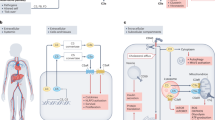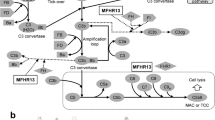Abstract
Universally expressed CD59 is the sole membrane complement regulatory protein that protects host cells from complement damage by restricting membrane attack complex assembly. The human gene encodes a single CD59, whereas the mouse gene encodes a duplicated CD59, comprising mCd59a and mCd59b, with distinct tissue distribution. Recently, we revealed that Sp1 regulates constitutive CD59 transcription and that canonical nuclear factor kappa light chain enhancer of activated B cells (NF-κB) and cyclic AMP-responsive element-binding protein (CREB) regulate inducible CD59 transcription. However, the mechanisms that underlie mCd59 regulation remain unclear. Here we demonstrate that Sp1 controls broadly distributed mCd59a expression, whereas serum response factor (SRF) and canonical NF-κB regulate selectively expressed mCd59b. Tumor necrosis factor-α in vitro and lipopolysaccharide in vivo remarkably enhance the expression of mCd59b but not mCd59a by activating SRF and NF-κB, thus protecting cells from complement attack. In addition, cAMP analog treatment also dramatically increases mCd59b but not mCd59a expression in a manner independent of CREB, SRF and NF-κB. Therefore, mCd59b but not mCd59a may be the responder to external inflammatory stimuli and may have an important role in complement-mediated mouse models of disease.
This is a preview of subscription content, access via your institution
Access options
Subscribe to this journal
Receive 6 digital issues and online access to articles
$119.00 per year
only $19.83 per issue
Buy this article
- Purchase on Springer Link
- Instant access to full article PDF
Prices may be subject to local taxes which are calculated during checkout





Similar content being viewed by others
Accession codes
References
Morgan BP, Marchbank KJ, Longhi MP, Harris CL, Gallimore AM . Complement: central to innate immunity and bridging to adaptive responses. Immunol Lett 2005; 97: 171–179.
Dunkelberger JR, Song WC . Complement and its role in innate and adaptive immune responses. Cell Res 2010; 20: 34–50.
Papadimitriou JC, Ramm LE, Drachenberg CB, Trump BF, Shin ML . Quantitative analysis of adenine nucleotides during the prelytic phase of cell death mediated by C5b-9. J Immunol 1991; 147: 212–217.
Esser AF . The membrane attack complex of complement. Assembly, structure and cytotoxic activity. Toxicology 1994; 87: 229–247.
Ollert MW, Kadlec JV, David K, Petrella EC, Bredehorst R, Vogel CW . Antibody-mediated complement activation on nucleated cells. A quantitative analysis of the individual reaction steps. J Immunol 1994; 153: 2213–2221.
Zhou X, Hu W, Qin X . The role of complement in the mechanism of action of rituximab for B-cell lymphoma: implications for therapy. Oncologist 2008; 13: 954–966.
Powell MB, Marchbank KJ, Rushmere NK, van den Berg CW, Morgan BP . Molecular cloning, chromosomal localization, expression, and functional characterization of the mouse analogue of human CD59. J Immunol 1997; 158: 1692–1702.
Qian YM, Qin X, Miwa T, Sun X, Halperin JA, Song WC . Identification and functional characterization of a new gene encoding the mouse terminal complement inhibitor CD59. J Immunol 2000; 165: 2528–2534.
Meri S, Waldmann H, Lachmann PJ . Distribution of protectin (CD59), a complement membrane attack inhibitor, in normal human tissues. Lab Invest 1991; 65: 532–537.
Baalasubramanian S, Harris CL, Donev RM, Mizuno M, Omidvar N, Song WC et al. CD59a is the primary regulator of membrane attack complex assembly in the mouse. J Immunol 2004; 173: 3684–3692.
Harris CL, Hanna SM, Mizuno M, Holt DS, Marchbank KJ, Morgan BP . Characterization of the mouse analogues of CD59 using novel monoclonal antibodies: tissue distribution and functional comparison. Immunology 2003; 109: 117–126.
Donev RM, Sivasankar B, Mizuno M, Morgan BP . The mouse complement regulator CD59b is significantly expressed only in testis and plays roles in sperm acrosome activation and motility. Mol Immunol 2008; 45: 534–542.
Qin X, Miwa T, Aktas H, Gao M, Lee C, Qian YM et al Genomic structure, functional comparison, and tissue distribution of mouse Cd59a and Cd59b. Mamm Genome 2001; 12: 582–589.
Qin X, Dobarro M, Bedford SJ, Ferris S, Miranda PV, Song W et al. Further characterization of reproductive abnormalities in mCd59b knockout mice: a potential new function of mCd59 in male reproduction. J Immunol 2005; 175: 6294–6302.
Zhang J, Hu W, Xing W, You T, Xu J, Qin X et al. The protective role of CD59 and pathogenic role of complement in hepatic ischemia and reperfusion injury. Am J Pathol 2011; 179: 2876–2884.
Wu G, Hu W, Shahsafaei A, Song W, Dobarro M, Sukhova GK et al. Complement regulator CD59 protects against atherosclerosis by restricting the formation of complement membrane attack complex. Circ Res 2009; 104: 550–558.
Ruiz-Arguelles A, Llorente L . The role of complement regulatory proteins (CD55 and CD59) in the pathogenesis of autoimmune hemocytopenias. Autoimmun Rev 2007; 6: 155–161.
Krus U, King BC, Nagaraj V, Gandasi NR, Sjolander J, Buda P et al. The complement inhibitor CD59 regulates insulin secretion by modulating exocytotic events. Cell Metab 2014; 19: 883–890.
Du Y, Teng X, Wang N, Zhang X, Chen J, Ding P et al. NF-kappaB and enhancer-binding CREB protein scaffolded by CREB-binding protein (CBP)/p300 proteins regulate CD59 protein expression to protect cells from complement attack. J Biol Chem 2014; 289: 2711–2724.
Qin X, Ferris S, Hu W, Guo F, Ziegeler G, Halperin JA . Analysis of the promoters and 5'-UTR of mouse Cd59 genes, and of their functional activity in erythrocytes. Genes Immun 2006; 7: 287–297.
Pangburn MK, Morrison DC, Schreiber RD, Muller-Eberhard HJ . Activation of the alternative complement pathway: recognition of surface structures on activators by bound C3b. J Immunol 1980; 124: 977–982.
Madonna R, Geng YJ, Bolli R, Rokosh G, Ferdinandy P, Patterson C et al. Co-Activation of nuclear factor-kappab and myocardin/serum response factor conveys the hypertrophy signal of high insulin levels in cardiac myoblasts. J Biol Chem 2014; 289: 19585–19598.
Li YP, Schwartz RJ . TNF-alpha regulates early differentiation of C2C12 myoblasts in an autocrine fashion. FASEB J 2001; 15: 1413–1415.
Wells MJ, Hatton MW, Hewlett B, Podor TJ, Sheffield WP, Blajchman MA . Cytokeratin 18 is expressed on the hepatocyte plasma membrane surface and interacts with thrombin-antithrombin complexes. J Biol Chem 1997; 272: 28574–28581.
Bonizzi G, Karin M . The two NF-kappaB activation pathways and their role in innate and adaptive immunity. Trends Immunol 2004; 25: 280–288.
Oeckinghaus A, Hayden MS, Ghosh S . Crosstalk in NF-kappaB signaling pathways. Nat Immunol 2011; 12: 695–708.
Hayden MS, Ghosh S . NF-kappaB in immunobiology. Cell Res 2011; 21: 223–244.
Baeuerle PA, Henkel T . Function and activation of NF-kappa B in the immune system. Annu Rev Immunol 1994; 12: 141–179.
Kanarek N, London N, Schueler-Furman O, Ben-Neriah Y . Ubiquitination and degradation of the inhibitors of NF-kappaB. Cold Spring Harb Perspect Biol 2010; 2: a000166.
Chai J, Tarnawski AS . Serum response factor: discovery, biochemistry, biological roles and implications for tissue injury healing. J Physiol Pharmacol 2002; 53: 147–157.
Arsenian S, Weinhold B, Oelgeschlager M, Ruther U, Nordheim A . Serum response factor is essential for mesoderm formation during mouse embryogenesis. EMBO J 1998; 17: 6289–6299.
Taylor A, Tang W, Bruscia EM, Zhang PX, Lin A, Gaines P et al. SRF is required for neutrophil migration in response to inflammation. Blood 2014; 123: 3027–3036.
Xie L, Sullivan AL, Collier JG, Glass CK . Serum response factor indirectly regulates type I interferon-signaling in macrophages. J Interferon Cytokine Res 2013; 33: 588–596.
Badea TD, Park JH, Soane L, Niculescu T, Niculescu F, Rus H et al. Sublytic terminal complement attack induces c-fos transcriptional activation in myotubes. J Neuroimmunol 2003; 142: 58–66.
Kilgore KS, Schmid E, Shanley TP, Flory CM, Maheswari V, Tramontini NL et al. Sublytic concentrations of the membrane attack complex of complement induce endothelial interleukin-8 and monocyte chemoattractant protein-1 through nuclear factor-kappa B activation. Am J Pathol 1997; 150: 2019–2031.
Tan NY, Khachigian LM . Sp1 phosphorylation and its regulation of gene transcription. Mol Cell Biol 2009; 29: 2483–2488.
Philipsen S, Suske G . A tale of three fingers: the family of mammalian Sp/XKLF transcription factors. Nucleic Acids Res 1999; 27: 2991–3000.
Bouwman P, Philipsen S . Regulation of the activity of Sp1-related transcription factors. Mol Cell Endocrinol 2002; 195: 27–38.
Chuang JY, Wang YT, Yeh SH, Liu YW, Chang WC, Hung JJ . Phosphorylation by c-Jun NH2-terminal kinase 1 regulates the stability of transcription factor Sp1 during mitosis. Mol Biol Cell 2008; 19: 1139–1151.
Hu W, Ge X, You T, Xu T, Zhang J, Wu G et al. Human CD59 inhibitor sensitizes rituximab-resistant lymphoma cells to complement-mediated cytolysis. Cancer Res 2011; 71: 2298–2307.
Acknowledgements
This research was supported by grants to WH from the National Natural Science Foundation of China (81171910, 81372258), the Major State Basic Research Development Program of China (2013CB910802) and the Program for Professor of Special Appointment (Eastern Scholar) at Shanghai Institutions of Higher Learning.
Author information
Authors and Affiliations
Corresponding author
Ethics declarations
Competing interests
The authors declare no conflict of interest.
Additional information
Supplementary Information accompanies this paper on Genes and Immunity website
Rights and permissions
About this article
Cite this article
Chen, J., Du, Y., Ding, P. et al. Mouse Cd59b but not Cd59a is upregulated to protect cells from complement attack in response to inflammatory stimulation. Genes Immun 16, 437–445 (2015). https://doi.org/10.1038/gene.2015.29
Received:
Revised:
Accepted:
Published:
Issue Date:
DOI: https://doi.org/10.1038/gene.2015.29



